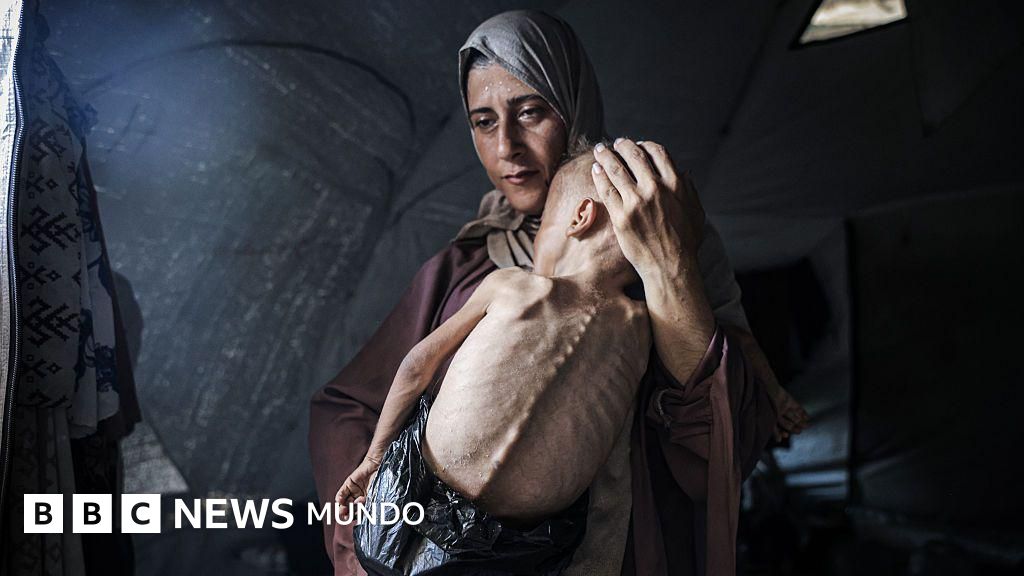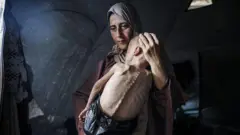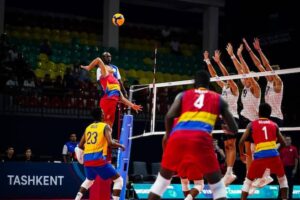

Image source, Getty Images
-
- Author, Redacción*
- Author's title, BBC News World
Its scarce skin barely contains the spine and ribs, which almost escape from its small body.
It is Mohamed Zakariya Ayyoub al-Matouq, a baby of a year and a half that, like other boys and girls, has become one of the most heartbreaking images of the famine situation that affects the inhabitants of Gaza in the middle of what is denounced as a block of Israel.
The little boy was portrayed with his mother by photographer Ahmed al-Arini on July 21 in a tent raised in the strip, where the most basic elements for the subsistence of the Gazaties are scarce.
Hedaya Al-Muta, Mohamed's mother, offered her heartbreaking testimony to the BBC.
“Now weighs 6 kilos, when he weighed 9th.
Hedaya explains that, due to the lack of food, Mohamed “cannot sit or stand like any child” and has developed “shrunk back” syndrome, as well as a dorsal protuberance.
“I have no means. My husband was killed in the war and I don't have anyone who provides, except God. I can't feed him because I'm alone. Hard work, but I can't give even a little baby formula. I'm exhausted,” he says.
The reporter Ahmed al-Arini told the Newshour program of the BBC the impact he had on him to capture the image of Hedaya and his wife who has turned the world around.
“I had to pause after each shot to regain breath and be able to continue,” he says.
The United Nations Organization (UN) said Thursday that it has 6,000 humanitarian aid trucks waiting to enter Gaza and warned that famine in the enclave “has never been so serious.”
Israel says that it has allowed the entry of enough help to Gaza, while blaming the UN for not being distributed in a timely manner. It also ensures that malnutrition cases are Hamas's responsibility.
The Benjamin Netanyahu government says that it will allow foreign countries to launch Gaza in the next few days.
Doctors Without Borders (MSF), on the other hand, ensures that their equipment is seeing “catastrophic levels of malnutrition.”

Image source, Getty Images
A bag like diaper
“This photo of the baby Mohamed took her when she was with her mother. They were displaced from her home in northern Gaza,” says Ahmed.
“They were in an absolutely empty store, except for a small oven. It really looked like a grave. And I took it because I wanted to show the world the extreme hunger that babies and children are suffering in the Gaza Strip.”
The photographer explains that little Mohamed “has not received milk, formula or vitamins.”
“And if you look at the photo close, you will see that it carries a plastic bag instead of a diaper. Due to the lack of humanitarian aid and medicines, prices have shot themselves, they have gone through the clouds, so no one in Gaza can allow them,” he says.
The Gaza Ministry of Health reported that 122 Palestinians have already died from malnutrition, of which at least 83 are children.
Ahmed, like other graphic reporters who have portrayed Gaza's situation in recent weeks, give an account of how complex that horror becomes registered: “Seeing how babies are suffering extreme hunger, and how emaciated that they are of course affects me, I am a human being.”
Therefore, says Ahmed, when he found Mohamed and Hedaya took him for a long time to take the photographs.
Unfortunately this is not the only baby who has found in those conditions.
“I have seen several cases like this. The other day I took some photos of a 17 -year -old boy who lost 25 kilos of weight in just one month. People do not find food in the Gaza Strip, there is an extreme hunger, but a famine, and people fight for a little help, risking their lives to get something.”

Image source, Getty Images
Ahmed himself also goes hungry.
“I have not tried a single bite of food since this morning,” he told the BBC this Thursday. “I am talking to you right now and I am very hungry. It's almost impossible to get food.”
“My nephews and nieces have been crying since yesterday, they have been asking their father for a piece of bread. That is all they need, and there is not enough for everyone,” he says.
At times, says the photographer, it is difficult to do his job.
“I walk to take my photos, and at the same time, while I do, they come dizziness, I lose your balance because I'm hungry, we are exhausted. I am also thirst, so we are all suffering.
I have seen many colleagues collapse for hunger and thirst. “
For his work, Ahmed says that he used to use an application to receive his payments, “but now, as the situation is so difficult, they charge a 40 %commission, so almost half of my salary is already lost before I can buy or allow me anything.”
The journalist explains that, in the midst of the blockade and the shortage of basic supplies, the products are traveled in a black market that almost no one can access.
“The little help that is entering Gaza is not enough for anyone, and everything that arrives is bags of flour, when the water also scarce. And of course, as the water is so scarce, prices in the black market have skyrocketed, so now the kilo of flour costs US $ 16,” he adds.
“Before the war, Gaza was beautiful, had clean and beautiful streets, now everything is destruction … the only means of transport available are carros thrown by donkeys.
We have retreated long before the Middle Ages. The social fabric is practically destroyed … people feel helpless and is exhausted by this war, and even more exhausted by hunger and thirst. “

Subscribe here To our new newsletter to receive every Friday a selection of our best content of the week.
And remember that you can receive notifications in our app. Download the latest version and act.





